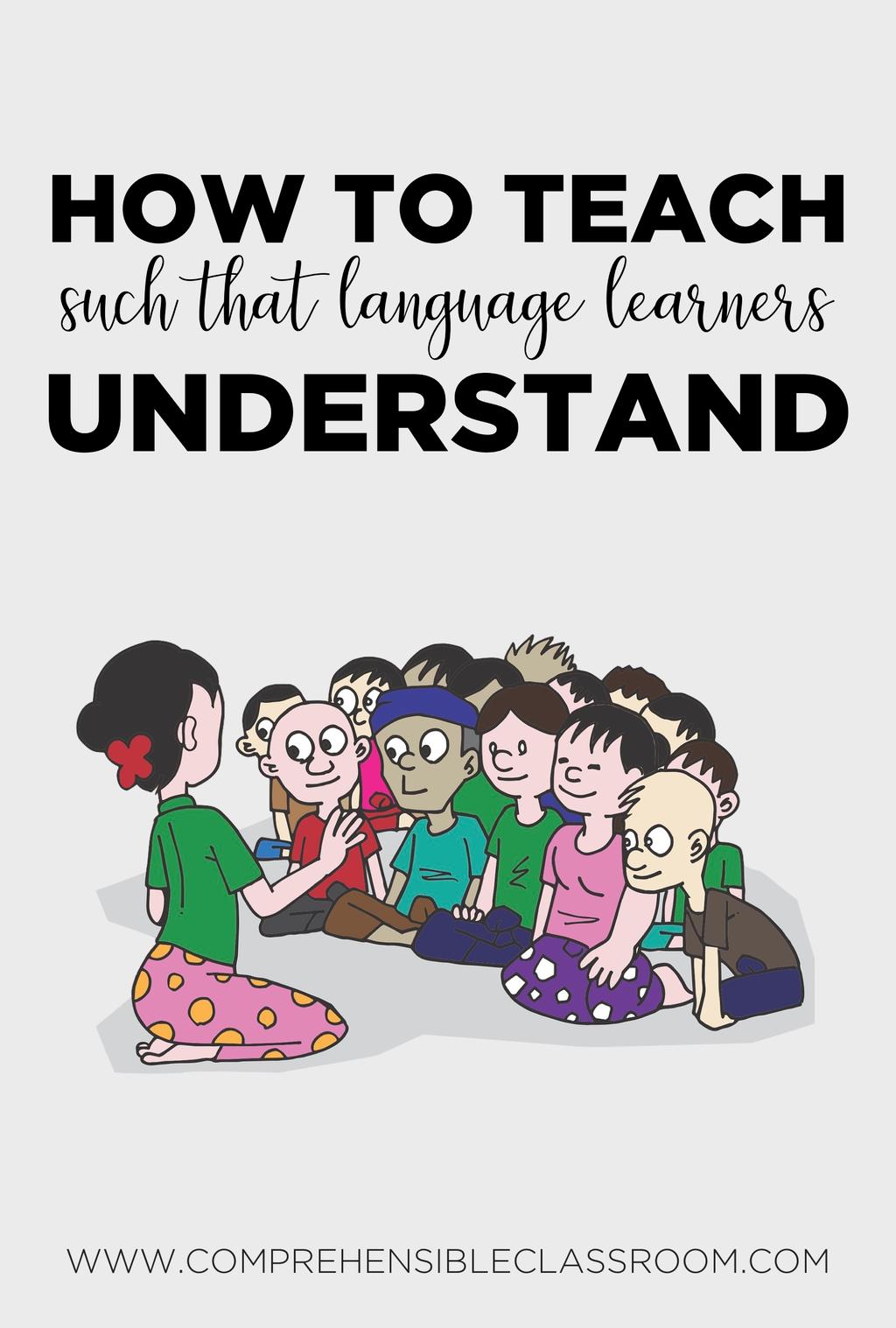If we want language to come OUT of our students’ mouths, we must get language IN to their heads. They need INput so that they can produce OUTput.
» Input is reading and listening
» Output is speaking and writing
This is common sense. A learner cannot utter an expression in a new language if they have never heard it or seen it. No one disagrees that input precedes output, and all language teachers are looking for ways to provide their students with input.
Yet not all input is created equal, and this is where we find some space for professional debate. If you’ve been with me for any length of time, you know that the kind of input that I’m after is comprehensible input:
Comprehensible input is language input that can be understood by listeners despite them not understanding all the words and structures in it. -TeachingEnglish.org
In other words, “comprehensible” means that the input is reasonably able to be understood by a learner or collective group of learners.
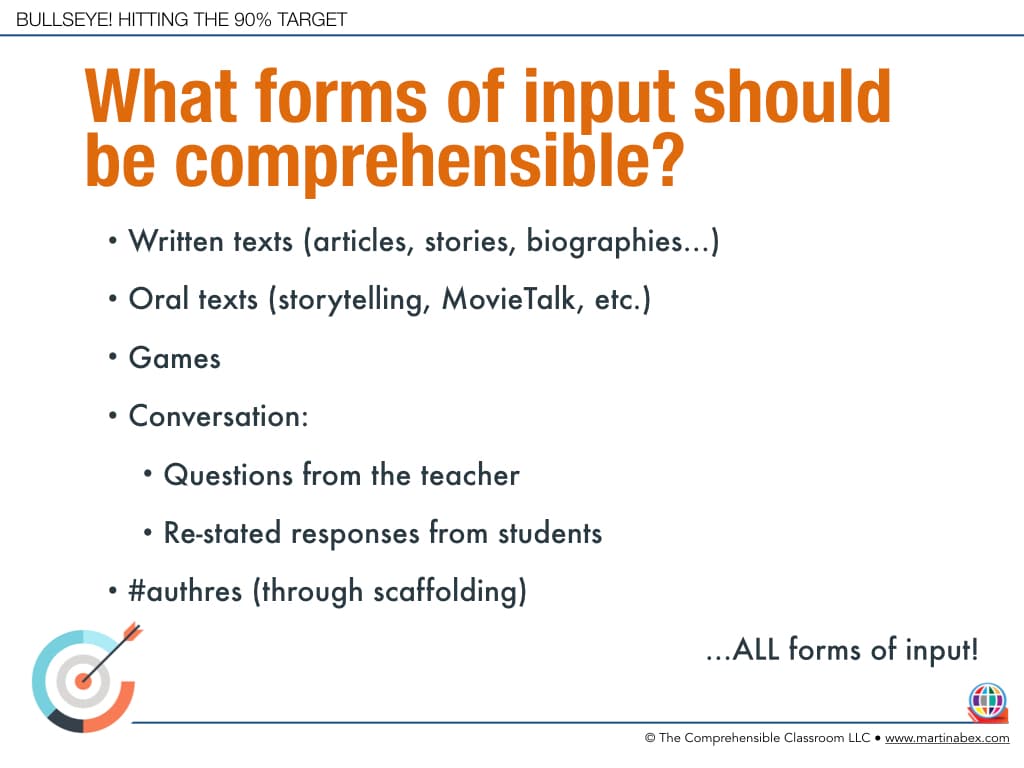
Krashen originally defined comprehensible input as language input at level “i + 1”; language input that is slightly more advanced than their current interlanguage.
With a range of linguistic competencies in a given class, however, “comprehensible” becomes quite subjective. What is comprehensible to one learner might be altogether incomprehensible to another. Meaningful utterances to one learner may be nothing more than noise to another.
As language teachers, we all try to speak to our students in such a way that they understand. We all try to give our students written texts that we think they will be able to make sense of! But how do we know that they DO understand what we think that they will understand? How do we take a written or oral text that is comprehensible (probably understandable) to most of our students and ensure that it is comprehenDED by all of our students? What checks and balances can we put in place to make sure that we are on the right track?
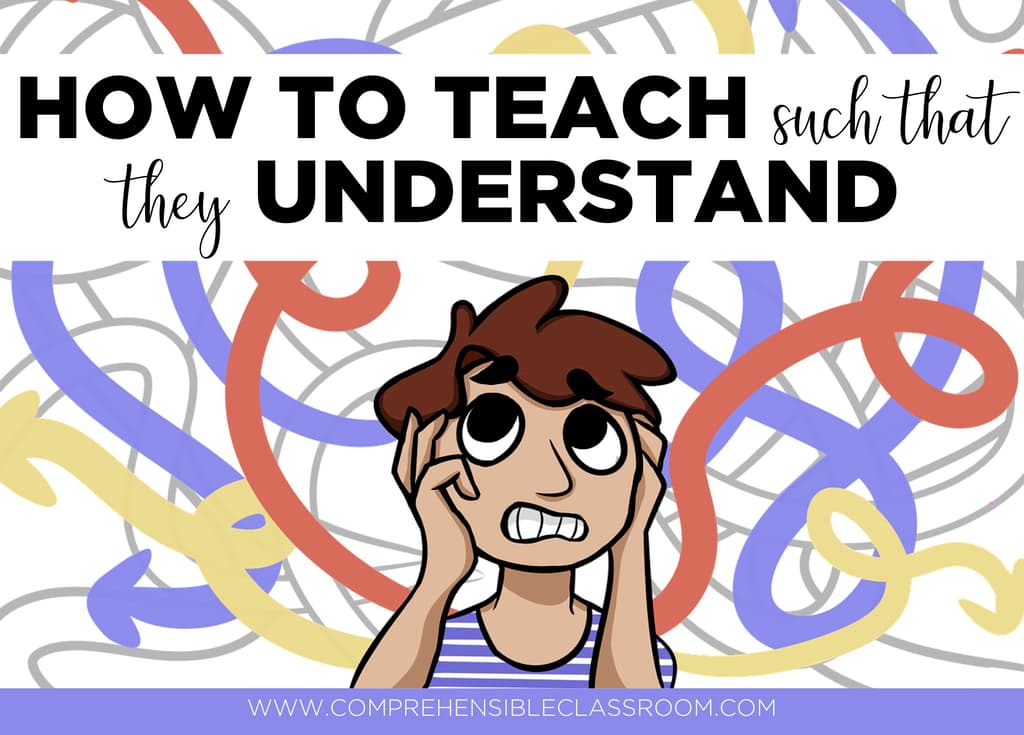
Moving from comprehensible to comprehended input
There are many comprehension supports that we can use (1) to help a learner understand a message and the individual words and phrases that we use to communicate it, (2) to determine whether or not an individual is understanding a message, and (3) to make adjustments to the message accordingly.
These supports are tools in your language teacher tool belt. Some of them are cheap tools—tools that won’t cost you blood, sweat, and tears to obtain. They are tools that come naturally to you. Other tools (skills) are very costly, and it will take weeks…months…years of work to add them to your tool belt.
Let’s dig in and explore the top comprehension support tools that we can use to take comprehensible input and ensure that it is comprehended by our learners.
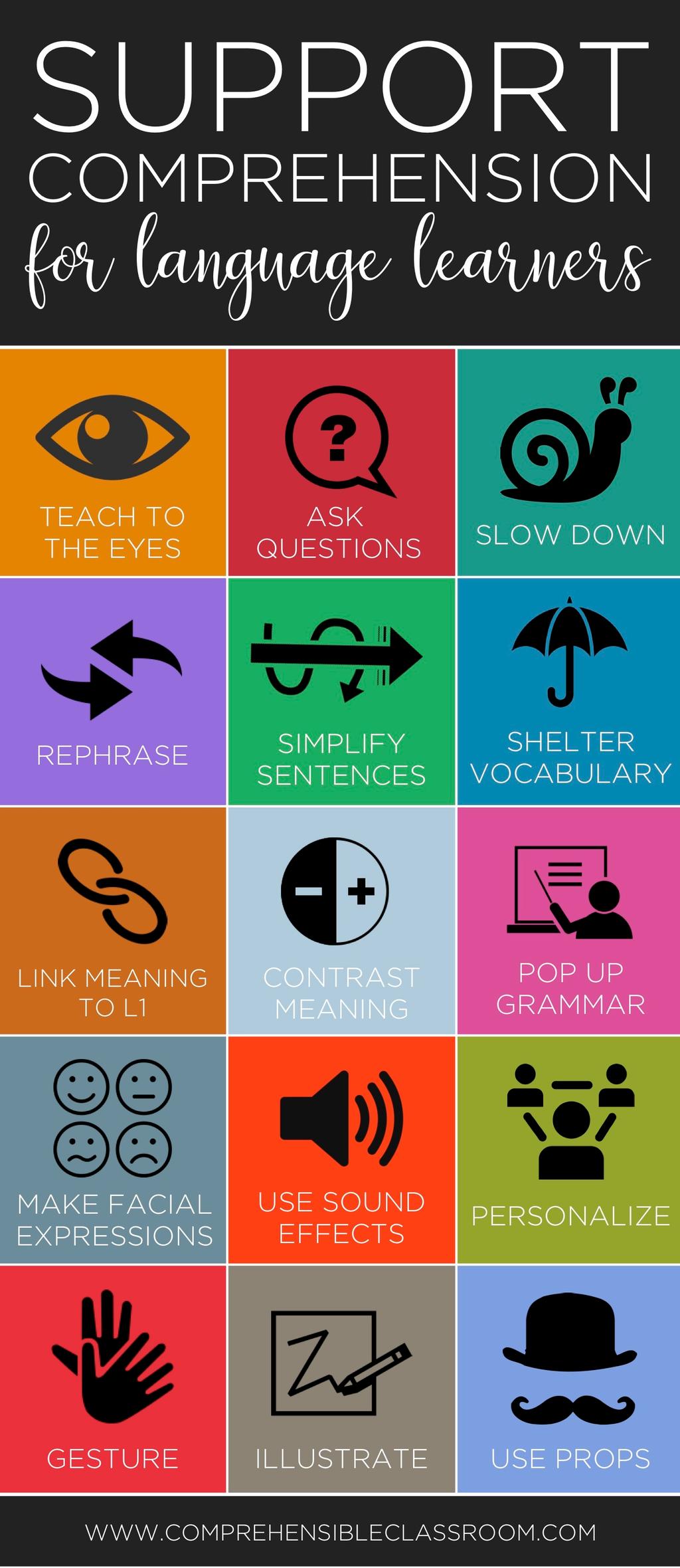
Teach to the eyes
Susan Gross coined this phrase, and all teachers—not just language teachers—should live and die by this tool. When you teach, look your students in the eye. Draw near to them and hold their gaze. As you do, you will see the sparkle of understanding. You will see the flicker of confusion. You will see their eyes dart away to look for clues to help interpret your message when the words themselves are not enough. You will connect with them as they hold your gaze, confident in their interpretation of your message. Teach to your students’ eyes.
Ask questions
Ask all kinds of questions! Ask confirmation questions (I went to the store. Did I go to the store?). Ask yes/no questions (Did I go to the store? Yes or no?). Ask either/or questions (Did I go to the store or to the movies?). Ask question-word-questions (Where did I go?). Ask follow-up questions (Why did I go to the store?). Ask comprehension questions (What did I just say in English?). Ask questions about the students’ lives (more on that later).Asking questions clarifies the meaning of the original statement in the learner’s mind. Asking questions confirms to them that they correctly understood the message or reveals to them a hole in comprehension. Asking questions allows them to hear the words again, moving them ever farther on the path to acquisition of a term. Asking questions well engages students and connects them with you and with each other.
Slow down
SLOW DOWN. Now slow down some more!! You think you are going as slow as you can go? Good! Now go slower!!
But what does “going slow” mean? It is so much more than rate of speech; words per minute. And I am not even going to write about this because Blair Richards has already written everything that you need to know about slowing down in this beautiful reflection on her experience working with a Mentor Teacher at iFLT 2018. Click here to learn what slowing down means.
Rephrase
You don’t have to wait for your students to not understand your message to rephrase it. Rephrasing is a fantastic tool that you can use preemptively to keep all learners on the same page in addition to using it as an ‘intervention’ when you realize that learners have not understood. I have been listening to The Green Ember with my kids in the car lately. With my oldest child just six years old, the language and text structure in The Green Ember is at times incomprehensible to my kids. Pair that with the fact that it is sometimes hard to hear (thank you, screeching 2 year old!) and that there are many distractions waiting outside the windows of the car (“half naked pine tree forest!”), and there are many times that I guess that my kids have not understood the last piece of the story.
So what do I do? I pause and I ask a question, “Did you understand that part?” and whether they answer “yes” or “no”, I respond with an affirmation and then rephrase the content: “That’s right!/Almost/You got it!…Picket was hurt really badly but he wanted everyone else to think he was tough and so he pretended that he wasn’t hurt”. You can rephrase things that you have said, language that students have read, or language produced by someone else (a recording, a classmate, etc.).
Simplify sentences
Simplifying sentences can mean two things. The first way to simplify a sentence is to cut out unnecessary information, communicating just the ‘meat and bones’ of the message. Instead of saying “The clean living room was bright and airy and sparkled in the light of the noonday sun pouring through the window shades”, you could say, “The living room was clean and sunny”.
The second way to simplify a sentence is to break it down into smaller pieces. Instead of saying, “I went to the grocery store with my mom to buy milk so that I could eat cereal for breakfast”, you could say, “I wanted to eat breakfast. I wanted to eat cereal. I didn’t have milk. I went to the grocery store. I went with my mom. We bought milk.” You’re not going to win a Pulitzer Prize for your writing, but your students are going to understand you better.
Shelter vocabulary
To shelter is to protect from something harmful—but what’s so dangerous about words?
I’ll tell you what. It’s NOT UNDERSTANDING. Guys, not understanding sucks. It’s stressful and it makes us feel dumb and inadequate and all around bad. Have you ever been in a situation in which someone is speaking to you—perhaps in another language, perhaps in broken language, perhaps too quietly, perhaps mumbled—and you ask them to repeat a few times and you still don’t get it? Not understanding something that another person wants you to understand doesn’t feel good. It feels bad. Also, it’s a roadblock that is very hard to get past and continue the conversation. We shelter vocabulary in order to shelter our students from not understanding.

If you want your students to understand you, you must use mostly words that they understand! This isn’t rocket science but it is a total paradigm shift from the ways in which most of us learned language and the ways that we learned to teach language. If you want students to understand you, you must limit the number of words that you are using. In particular, you must limit the number of lemmas (root words) that you are using. Sheltering students from large quantities of unfamiliar words will allow them to skillfully use context clues to fill in the holes left in texts that are filled with mostly familiar words.
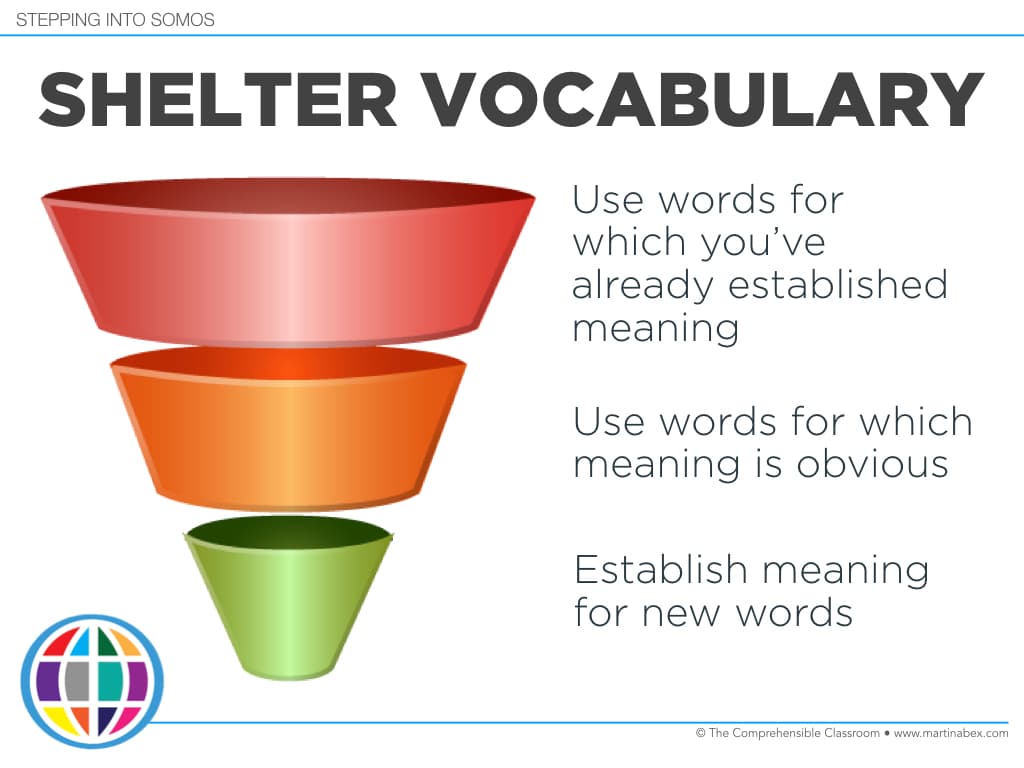
Link meaning to L1
If you are teaching a group of students that share a common language already—whether or not it is their first language—linking meaning between the target language and the common language is an immensely useful tool to ensure that input is comprehended. You can tell students what specific words or phrases when you first use them (ex: ‘quiere’ means ‘wants’), or you can check for comprehension by asking questions about the meaning of utterances (ex: “Bob quiere un elefante…what does that mean in English?”). Linking meaning to L1 is my preferred method of establishing meaning for new words and phrases that my students read and hear, and I prefer to write out the pairs so that students can see them and reference them during conversations. You will see many teachers that use comprehension based methods writing the target language with a BLACK marker and L1 in a BLUE marker, but really you can do whatever you want :).
Contrast meaning
After you’ve made a statement, a fairly simple and often fun way to support students’ comprehension is to make a parallel statement or set up a parallel scenario. This is the beauty of the “Three Ring Circus” and “Contrastive Grammar”, but contrasting meaning can happen in any context.
For example:
El elefante vive en África. (The elephant lives in Africa.)
El cocodrilo no vive en África. El cocodrilo vive en Australia. (The crocodile lives in Australia.)
Yo no vivo en África. Yo no vivo en Australia. Yo vivo en América del Norte.
By contrasting these statements, students’ comprehension of the verb vivir (to live), the various continents, as well as different forms of the verb vivir (vive/vivo) is supported. Each new, contrasting statement that you bring in will confirm and clarify the meaning of the original statement as well as helping to interpret the new information with increased fluency and accuracy.
Pop up grammar
While we know that language’s internal structure does not consist of rules, and for that reason there are always exceptions to rules that we try to use to describe how language works, it can be helpful to some students to learn general rules about the target language. Learners—in particular high aptitude learners—may be able to better understand utterances when they apply background knowledge about the structure of language to the new utterance. For example:
Teacher: El elefante vivE en África. Yo vivO en Vermont. The ‘o’ on the end of ‘vivo’ means that I am the one the verb is referring to, I am the one that lives in Vermont.
Pop up grammar should be really, really short ‘asides’—quick comments that give concise information about a specific linguistic feature. And while they are traditionally viewed as a tool to help learners better interpret the language moving forward, they can also be helpful in removing roadblocks for those learners whose focus on the form of the language keeps them from focusing on the meaning. This crippling focus on form is a habit that needs to be broken, and pop-up grammar is an easy way to give those learners a crutch to keep moving forward even when they don’t understand every single discreet item in an utterance in addition to its role in the language as a whole.
Personalize
At surface level, personalization is an example of some of the tools that we have already covered: asking questions and contrasting meaning. But personalization is a special kind of question-asking; a special kind of meaning-contrast, and so it merits the status of a stand-alone tool.
We learn what we feel. Connecting what students hear and what they read in the target language to their lives, their background knowledge, and their ideas will help them to internalize it more profoundly and more quickly. In one of my sessions at iFLT last week, I was demonstrating a game that worked with the topic of the World Cup. One of the questions was about who had scored the most goals during the 2018 World Cup and presented numbers of goals. Well, I had no idea when I wrote that question that there was a big controversy surrounding a goal by Harry Kane. How did I find out? One of Harry Kane’s biggest fans was in my workshop, and he answered the question only begrudgingly, ensuring that everyone in the class knew that he was choosing the best answer out of what he believed to be all incorrect answers.
And you know what? I live for those moments. Look for opportunities to talk with your students about the things that get them excited, angry, sad, scared, and make them laugh! Find out what they care about and then press in. We remember what we feel. If you want your students to remember the language, use it to talk about memorable things.
Link meaning to visuals and sounds
The last six tools that I use to support comprehension for language learners are all related; each one links meaning of the L2 utterance to a visual or to a sound.
- Make facial expressions
- Use sound effects
- Gesture
- Illustrate
- Use props
- Miming/acting
If you have played Charades or Pictionary or Cranium or any game like those, you know that some people are more skilled than others at making themselves understood using these tools! As with all of the other tools that I have described in this post, you can become more skilled than you are right now at using these tools to support learners’ comprehension of L2. In fact, I attended an Improv session with Gary DiBianca at OFLA 2018 in which he focused on helping attendees to consider how to better use our voices, our bodies, and our environments to make ourselves understood. Learn how to draw better. Learn how to look differently at the objects in your classroom, to see the possibilities that they offer as props. Learn how to use sound effects in creative ways. Train yourself to use gestures as you speak the target language to your students. Make faces in front of your mirror as you say expressions in your target language. Play Charades! Play Pictionary! Practice, practice, practice, and I am confident that you will reap the rewards of your hard work as you offer new, clearer links in meaning to your students.
Practice makes perfect
As you can see, we have many tools available to us as we strive to ensure that our students are understanding what we think they will understand—so many, in fact, that it is all quite overwhelming. How can you guarantee that you are making use of all of the tools that are available to you? How can you be sure that you have chosen the right tools for a given job?
Practice. Practice, practice, practice.
Psychology researcher Philippa Lally published a study demonstrating that on average, it takes 66 days to form a habit.
SIXTY SIX DAYS.
How long have you been practicing the skill of slowing down? How long have you been working with concerted effort to shelter vocabulary? For how many days in class have you reminded yourself to simplify the sentences you speak to your students?
In Lally’s study, participants formed habits after as few as 18 and as many as 254 days. On average it took them 66—but that was within a huge range!
Some of these tools are ones that you have already added to your tool belt; they are already habits. Others will come easily to you. And some of them will take continual, concerted effort. Form the habit of using each one of these tools. Focus on one or two at a time until you find yourself using them without thinking about it. And once you reach that point, look for opportunities to work with a trained Coach to hone your skills even further. Don’t try to get better at all of them at the same time; focus your attention on them sequentially.
I made a second version of the the graphic from this post that you can print out and use as a way to organize and strategize your skill building. Color in or cross off any tools that you think you are already doing really well. If you are feeling really brave, try teaching a mini lesson in front of or or to a trusted colleague. Have that colleague tell you what you did best!! (Need to find a trusted colleague? Check out Mike Peto’s list of Regional PLCs for language teachers.) Then look at which tools are left on the board and circle 1-2 to focus on as you head into the coming school year. Keep them visible in your physical space as a reminder to you to employ them as you strive to make your comprehensible input comprehended! Revisit the graphic each Friday and reflect on how well you are progressing toward your goal of making that tool a habit.

Make this year your most comprehensible year yet!
——
If you are interested in bringing a Coach to your school or organization to work with your teachers, I would love to connect you with the Coaching Team so that they can in turn connect you with an experienced coach in your area. Contact me! I mentioned Gary DiBianca’s Improv workshop in this post, and I would highly recommend bringing him to your district or organization to work with teachers to improve their comprehension based skills. Gary is one of the most experienced coaches and trainers in the CI world, and the Improv angle is just one of the ways he helps teachers to get better at what they do!
